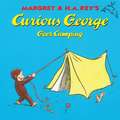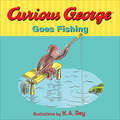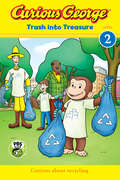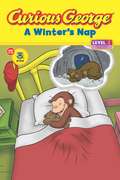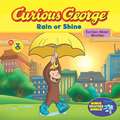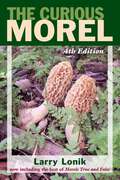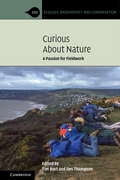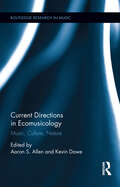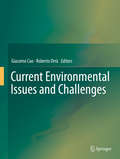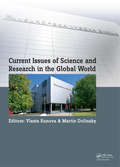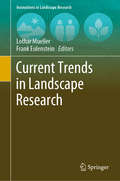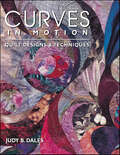- Table View
- List View
Curious George Discovers the Rainbow (Curious George)
by H.A. ReyColor Curious George amazed when he learns how science and weather turn rain into rainbows! In this exciting new Curious George series all about discovery, George&’s city friends Betsy and Steve are taking their first trip to visit him in the country. When a light rain casts a stunning rainbow in the sky, George is introduced to all the beautiful colors of the spectrum! Come along as he chases the rainbow for his pot of gold and learns all about how rainbows occur and even how to create his own. Based on the Emmy-winning PBS show, this story is filled to the brim with additional facts, real photos, experiments, activities, and more. Learning about science has never been so much fun!
Curious George Discovers the Seasons
by H. A. ReyThe seasons are changing and winter is closing in. George has toys for warm weather and toys for snowy weather—but what’s a monkey to do when winter days are just plain cold? When he decides to ignore the weather and play with his wading pool and bubbles, George learns some interesting things about weather, temperature, and freezing and melting. Learn all about the four seasons with your favorite monkey! Based on the Emmy-winning PBS show, this story is filled to the brim with additional facts, real photos, experiments, activities, and more. Learning about science has never been so much fun!
Curious George Discovers the Stars (Curious George)
by H.A. ReyCurious George is too young to stay up all night, but before he gets his ZZZs he&’s going to learn as much as he can about astronomy! George loves summer nights in the country—that&’s where he does his best stargazing. When his friend Bill says that nobody knows how many stars there are, George is determined to count! But how will he keep track? Come along as George learns all about stars, constellations, and the night sky. Based on the Emmy-winning PBS show, this story is filled to the brim with additional facts, real photos, experiments, activities, and more. Learning about science has never been so much fun!
Curious George Goes Camping
by H. A. ReyGeorge and the man with the yellow hat are going camping! George tries to be helpful, but after he upsets a neighboring camper, he is chased into the woods and gets lost. Before long, an encounter with a cute forest creature throws George into a chain of outrageous events that allows him to find a way to be helpful after all.
Curious George Goes Camping
by Margret ReyWhen the man with the yellow hat takes George camping, George is very excited. There is so much to do at the campsite-pitching a tent, gathering water, meeting fellow campers-that George hardly knows where to begin (he only hopes the day will end with a roasted marshmallow!). When George’s knack for unintentional mischief gets him lost deep in the woods, George is scared . . . and being sprayed by a skunk only adds to the trouble. But George puts on a brave face, and he ends up saving the day when he puts out a small fire that could have endangered the forest.
Curious George Goes Fishing (Curious George Ser.)
by Margret ReyWhen this mischievous monkey casts off, he gets tangled up in misadventure. Don’t miss the boat when it comes to Curious George and fishing fun! Inspired by a vignette in the classic Curious George Flies a Kite, this amusing episode shows George at his curious best trying to catch a fish.Praise for the Curious George books“What distinguishes the George stories is where the trouble is—almost never in a person, never in humanity. George lives in a super benign world, even if it is often strange and unfamiliar to him. This is different than living in a world that is familiar but crowded with evil or indifference . . . George is at once an impossible monkey, a fantasy, and also, simply, one of us.” —The New Yorker“Curious George certainly deserves a spot on the shelf, and these engaging stories will provide a good exercise in imagination and creativity.” —The Horn Book
Curious George Grows a Garden: The Perfect Carrot and Plants a Seed (CGTV)
by H.A. ReyGeorge works on his green thumb in this special set of two stories based on the popular animated series! This double early reader features two favorite stories from the Emmy Award-winning PBS show, Curious George Plants a Seed and Curious George The Perfect Carrot! In Curious George Plants a Seed, everyone&’s favorite monkey has to make a few planting mistakes before his green thumb starts to kick in. In Curious George The Perfect Carrot, George learns how to grow a beautiful prize carrot, and then unselfishly uses it to help his neighbor Bill find his lost bunnies. Includes fun facts about supporting locally grown food, a bean sprout planting activity, and a delicious recipe for carrot muffins!
Curious George Plants a Tree (Curious George)
by Margret Rey H.A. ReyGeorge goes green! &“This picture book offers young children an appealing introduction to reusing and recycling.&”—Booklist George loves to go to the science museum. So, when he finds out that the museum is planning a &“Green Day&” dedicated to recycling and planting trees, George is curious and wants to help out! But little monkeys eager to help can sometimes become little monkeys getting into trouble. When George begins to find and recycle things around town that aren&’t quite ready for the recycle bin, he gets into a jam. Thankfully, George isn&’t the only one who wants to help. The whole community can&’t wait to lend a hand—and help George and the museum plant some trees! Originally published to coincide with the opening of the Margret & H.A. Rey Center in Waterville, New Hampshire, a model for energy conservation offering literary, educational, and other programs, this book also includes kid-friendly tips for helping the environment.
Curious George: (cgtv Bilingual Reader) (Curious George)
by H. A. ReyIn this Green Light Reader based on Curious George, the Emmy Award-winning PBS TV show, Curious George is part of a team challenge to clean up the city streets -- until he finds hidden treasures along the way! George is part of a team challenge to help clean up the city on Pretty City Day. But when he finds hidden and forgotten treasures along the way, he realizes he's collecting more treasures than he is trash! If he wants to help his team win the challenge, he'll need to sort out his growing stash of treasures and see which ones he really wants to keep. But how? This Green Light Reader based on Curious George, the Emmy Award-winning PBS TV show, also includes bonus activities to help reinforce the concepts presented in the story.
Curious George: A Winter's Nap
by H. A. ReyAfter learning about hibernation, George decides that the best way to spend the cold winter months is the way that bears do it—fast asleep! But first it’s too bright in his room; then it’s not cave-like enough; and then it’s too loud. When George finally does get to sleep, he wakes up to discover that he slept only one night, not the whole winter! Will George be convinced that winter can be a wonderland of fun after all? Includes a question-and-answer activity on hibernation as well as a craft project to make your own teddy bear cave.
Curious George: Rain or Shine
by H. A. ReyGeorge wants to play outside, but the weather keeps changing his plans! He decides to create a weather journal by drawing pictures of the sky each day. But George soon discovers that predicting the weather isn’t easy. After rain ruins his picnic and he stays indoors on a beautiful sunny day, he decides to study wind patterns. Then the city’s weather station loses its satellite, and the scientists turn to George for help—but is he ready for his debut as a meteorologist?
Curious Morel
by Larry LonikThis new edition of The Curious Morel combines the best of Lonik's three books into one.
Curious Naturalists
by Dr Niko TinbergenDr. Niko Tinbergen was well known as a naturalist and a student of animal behaviour in England, on the Continent and in the United States. Ever since he was a young student in Holland he had been curious about nature, and in this book he sets out some of the facts that 25 years of curiosity gave him.As a biologist, anything living was his province—the bee-killing wasps and the digger wasps of the Dutch sand dunes; the Snow Bruntings and Phalaropes of Greenland; Hobbies and other hawks; moths and butterflies in various parts of England and Holland; Black-headed Gulls of the Ravenglass nature reserve, Cumberland, the Kittiwakes and Eider Ducks of the Farne Islands off the coast of Northumberland.Readers cannot fail to be struck—and possibly sometimes amused—by the patience and ingenuity shown in the field studies undertaken by Dr. Tinbergen and his fellow naturalists—and which are now passed on for the benefit and interest of his readers. The studies were always undertaken seriously, but this did not prevent Dr. Tinbergen from writing about them in the liveliest way; he realised that quite often he and his friends must have seemed to onlookers to be very curious naturalists indeed.
Curious about Nature: A Passion for Fieldwork (Ecology, Biodiversity and Conservation)
by Des Thompson Tim BurtNotwithstanding the importance of modern technology, fieldwork remains vital, not least through helping to inspire and educate the next generation. Fieldwork has the ingredients of intellectual curiosity, passion, rigour and engagement with the outdoor world - to name just a few. You may be simply noting what you see around you, making detailed records, or carrying out an experiment; all of this and much more amounts to fieldwork. Being curious, you think about the world around you, and through patient observation develop and test ideas. Forty contributors capture the excitement and importance of fieldwork through a wide variety of examples, from urban graffiti to the Great Barrier Reef. Outdoor learning is for life: people have the greatest respect and care for their world when they have first-hand experience of it.
Curious by Nature: One Woman's Exploration of the Natural World
by Candace SavageThe author of Strangers in the House examines nature&’s connection to herself and humanity in this collection of essays.Curious by Nature showcases Candace Savage&’s exploration of the varied ways we relate to wildlife from our retelling of fairytales about the big, bad wolf to our struggles to find a balance between harvesting trees and allowing grizzly bears the space to roam. Along the way, she asks intriguing questions to which she sets out to find answers, such as what brings out the mothering instinct in mammals, what are the forces behind the spectacular displays of the northern lights, and just how do crows calculate the optimum height from which to drop their whelks? Savage has spent the last twenty-five years exploring our complex relationships with the natural world: our prejudices, our growing body of scientific knowledge, our awe. She is particularly interested in bridging the gap between mythology and science, between longing and fact. Creating a livable future for ourselves and for other species, she believes, calls for both knowledge and love, and a deep sense of the value of wildness. This book is a record of Savage&’s ongoing quest to engage readers in a conversation that enriches our lives and the lives of the animals whose stories she tells.Praise for Curious by Nature &“Whimsical . . . . Though Savage is distressed by this &“destruction that we, as high-end consumers of the world's splendor, are leaving in our wake,&” the purpose of her essays is not to incite indignation but "to bring the ungraspable reality of the non-human world into clearer focus.&” In this she succeeds admirably.&” —Publishers Weekly
Current Directions in Ecomusicology: Music, Culture, Nature (Routledge Research in Music)
by Aaron S. Allen Kevin DaweThis volume is the first sustained examination of the complex perspectives that comprise ecomusicology—the study of the intersections of music/sound, culture/society, and nature/environment. Twenty-two authors provide a range of theoretical, methodological, and empirical chapters representing disciplines such as anthropology, biology, ecology, environmental studies, ethnomusicology, history, literature, musicology, performance studies, and psychology. They bring their specialized training to bear on interdisciplinary topics, both individually and in collaboration. Emerging from the whole is a view of ecomusicology as a field, a place where many disciplines come together. The topics addressed in this volume—contemporary composers and traditional musics, acoustic ecology and politicized soundscapes, material sustainability and environmental crisis, familiar and unfamiliar sounds, local places and global warming, birds and mice, hearing and listening, biomusic and soundscape ecology, and more—engage with conversations in the various realms of music study as well as in environmental studies and cultural studies. As with any healthy ecosystem, the field of ecomusicology is dynamic, but this edited collection provides a snapshot of it in a formative period. Each chapter is short, designed to be accessible to the nonspecialist, and includes extensive bibliographies; some chapters also provide further materials on a companion website: http://www.ecomusicology.info/. An introduction and interspersed editorial summaries help guide readers through four current directions—ecological, fieldwork, critical, and textual—in the field of ecomusicology.
Current Environmental Issues and Challenges
by Giacomo Cao Roberto OrrùFew books currently exist that cover such a wide spectrum of topics. The chapters dealing with air pollution from mobile sources, air pollution and health effects and air quality modelling fall into the air pollution category while the ones related to microalgae for carbon dioxide sequestration/biofuels production, fuel cells, and solar energy technology, respectively, can be ascribed to the energy topic. Several technologies to handle a wide spectrum of environmental pollutants are taken into account in numerous chapters. The chapter on biodiversity is clearly related to the conservation issue, while the water pollution subject is tackled by the chapter on water quality monitoring. Finally, a general analysis on green business, as well as a chapter on grid/cloud computing technology for collaborative problem solving and shared resources management conclude the work. Because of its breadth of coverage, this book is particularly useful as a graduate text.
Current Issues of Science and Research in the Global World: Proceedings of the International Conference on Current Issues of Science and Research in the Global World, Vienna, Austria; 27-28 May 2014
by Vlasta Kunova Martin DolinskyThis book contains the papers presented at the International Conference on Current Issues of Science and Research in the Global World, held at the premises of the Vienna University of Technology from May 27 to May 28, 2014. The book represents a significant contribution to Law, Economics, Information & Communication Technologies, Journalism and
Current Topics in Soil Science: An Environmental Approach
by Swapna MukherjeeSoil is an important but often neglected element of the climate system. It is the second largest carbon store, or ‘sink’, after the oceans. Despite being a fundamental resource that supports all kinds of life on Earth, concerns related to soil are often not included as an important environmental issue. Climate changes put soil under pressure. The increasing concentration of carbon dioxide in our atmosphere may cause the microbes in the soil to work faster to break down organic matter, potentially releasing even more carbon dioxide. The soil moisture content is being constantly affected by rising temperatures and changes in precipitation patterns and future projections show that this may continue. This book presents current environmental issues and their remedies for soil which are mainly based on soil degradation, soil pollution and the effect of climate change on the soil. Adding xenobiotic chemicals or other alterations in the natural soil environment for agricultural, industrial or urban purposes result in a decline in the soil quality due to improper use or poor management, which is a serious environmental problem. The book is divided into five parts - soil science, soil physics, soil chemistry, soil biology and soil environment. The first part “Soil Science” serves as the introduction to the book and discusses some common topics such as soil formation, mineralogy, taxonomy, quality and analytical techniques. The second part “Soil Physics” is mainly concerned with the physical properties and processes of soil and their association with effects on air, water and temperature. Soil Chemistry, the third part, discusses the chemical reactions and processes between inorganic and organic components. The fourth part “Soil Biology” explains the biological properties and processes of the soil, with special concern to microbial diversity and its effect on the ecology. Lastly, the fifth part “Soil Environment” discusses the current environmental problems such as climate change and soil pollution, including processes to mitigate these issues through carbon sequestration, nutrient management and land management.
Current Trends in Landscape Research (Innovations in Landscape Research)
by Lothar Mueller Frank EulensteinThis book presents definitions, key concepts and projects in landscape research and related areas, such as landscape science and landscape ecology, addressing and characterising the international role, status, challenges, future and tools of landscape research in the globalised world of the 21st century. The book brings together views on landscapes from leading international teams and emerging authors from different scientific disciplines and regions of the globe. It describes approaches for achieving sustainability and for handling the multifunctionality of landscapes and includes international case studies demonstrating the great potential of landscape research to provide partial sustainable solutions while developing cultural landscapes and protecting semi-natural landscapes. It is intended for scientists from various disciplines as well as informed readers dealing with landscape policies, planning, evolvement, management, stewardship and conservation.
Current Trends in Wildlife Research (Wildlife Research Monographs #1)
by Rafael Mateo Beatriz Arroyo Jesus T. GarciaThis book, the first in the "WildlifeResearch Monograph" series, defines "wildlife research" in a variety ofcontexts and reviews recent research trends. The authors present the currentdevelopments they have identified using bibliometric analyses of the mostcommon, relevant and emerging topics in wildlife research over the last three decades. Diverse aspects of wildlife research are discussed, including wildlifedemography, infections spread between wildlife, livestock and humans, habitatrequirements and management, as well as the effects of renewable energy andpollutants on wildlife. Furthermore the authors explore topics like advances inthe study of species distribution, invasive species, use of molecular markersin wildlife studies and the sustainability of wildlife exploitation andconservation conflicts. The book offers a comprehensive overview of advances inwildlife research in the last decades.
Current Trends in the Representation of Physical Processes in Weather and Climate Models (Springer Atmospheric Sciences)
by David A. Randall J. Srinivasan Ravi S. Nanjundiah Parthasarathi MukhopadhyayThis book focuses on the development of physical parameterization over the last 2 to 3 decades and provides a roadmap for its future development. It covers important physical processes: convection, clouds, radiation, land-surface, and the orographic effect. The improvement of numerical models for predicting weather and climate at a variety of places and times has progressed globally. However, there are still several challenging areas, which need to be addressed with a better understanding of physical processes based on observations, and to subsequently be taken into account by means of improved parameterization. And this is all the more important since models are increasingly being used at higher horizontal and vertical resolutions. Encouraging debate on the cloud-resolving approach or the hybrid approach with parameterized convection and grid-scale cloud microphysics and its impact on models’ intrinsic predictability, the book offers a motivating reference guide for all researchers whose work involves physical parameterization problems and numerical models.
Curves in Motion: Quilt Designs & Techniques
by Judy B. DalesWorking with curves in quilts opens the door to a world of immense beauty, excitement, and grace. Quiltmaker Judy B. Dales teaches you her methods for creating free-form curved designs. • Step-by-step instructions take you from the design stage through making the master pattern and templates, demonstrating that curves need not be complex or difficult to be effective. • Special techniques showyou how to use registration and intersection marks to ensure perfectly flat pieced tops. • Learn to create contrasts using the color, value, and texture of your fabrics. • Includes 5 projects ranging from intermediate skill level to advanced. Photographs of over 50 finished quilts provide creative inspiration.
Custer State Park
by Tom DomekCuster State Park is one of the largest and most beautiful state parks in the nation. From towering granite spires and pine-draped mountains to trout streams and remote savanna, the park offers scenic wonders and recreational opportunities seldom matched on the Northern Great Plains. First established as a state forest in 1912, today the park is home to one of the largest bison herds in the country, as well as other rare flora and fauna. Prior to settlement, the Black Hills were Lakota territory. After gold was discovered along French Creek in 1874, the government waged war on the Lakota, forcing them onto reservations, and settlers rushed to the region. Photos and narrative in this book provide an intriguing overview of the park's rich natural and social history. Whether the subject is Cathedral Spires or Sylvan Lake, General George Custer or Black Elk, Custer State Park will engage those who value history and the last few unspoiled places left in the country.
Cut Super Climate Pollutants Now!: The Ozone Treaty's Urgent Lessons for Speeding Up Climate Action (Resetting Our Future)
by Alan Miller Stephen O. Andersen Durwood Zaelke'Lays out an absolutely essential part of initial climate action in the US and other countries. Climate policymakers need to read this book, now.' James Gustave Speth, former chair, US Council on Environmental Quality.We have a decade or less to radically slow global warming before we risk hitting irreversible tipping points that will lock in catastrophic climate change. The good news is that we know how to slow global warming enough to avert disaster. Cut Super Climate Pollutants Now! explains how a 10-year sprint to cut short-lived &“super climate pollutants&” – primarily HFC refrigerants, black carbon (soot), and methane – can cut the rate of global warming in half, so we can stay in the race to net zero climate emissions by 2050.



